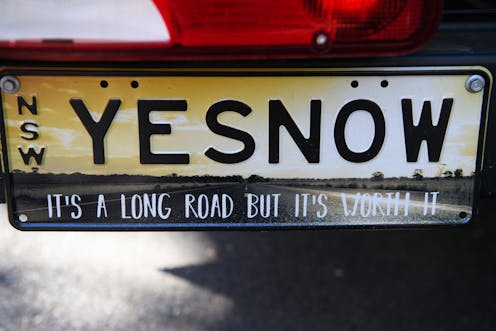Source: The Conversation (Au and NZ) – By Laurel Fox, PhD candidate, The University of Queensland

Bianca de Marchi/AAP
The Voice is a simple idea. The proposed amendment to Australia’s Constitution is short and sweet.
Yet the referendum debate is at risk of inundation, and too often misses the point. While there are many things the Voice cannot do, there is one thing it can do.
It offers a permanent, public and culturally distinct way forward for Indigenous consensuses to develop and find their rightful place in national politics.
Read more:
Solicitor-general confirms Voice model is legally sound, will not ‘fetter or impede’ parliament
The past as prologue to the present
The Voice is rehearsed rather than radical. National Indigenous representative bodies have been on and off the agenda for 50 years. Australia has had three formalised national Indigenous representative bodies between 1973 and 2005. The history of this is significant.
Colonialism radically disrupted traditional governance. While country and culture remain a bedrock of Indigenous identities, from the 1920s an Indigenous-led movement developed an agenda that favoured commonwealth over state power and lobbied for input at the national level.
This occurred alongside the Commonwealth’s increasing involvement in Indigenous affairs, a dynamic entrenched by the 1967 referendum. By 1967, the Commonwealth could not be seen to countenance the formulation of law and policy without Indigenous input.

Museum of Contemporary Aboriginal Australian History
National governments needed a way to obtain advice from Indigenous peoples. Liberal Prime Ministers Holt, Gorton and McMahon all acknowledged this.
But it was Gough Whitlam who established the first such representative body: the National Aboriginal Consultative Committee (1973–1977). Malcolm Fraser replaced this with the National Aboriginal Conference (1977–1985) and Bob Hawke legislated the Aboriginal and Torres Strait Islander Commission (1989–2005).
At their core, these bodies involved Aboriginal and Torres Strait Islanders choosing their own representatives to proffer advice to the Commonwealth. While the first two bodies were clipped, each collected Indigenous viewpoints and formulated national agendas.
A smattering of topics covered from the 1970s include land rights, treaty, recognition of colonisation without consent, police brutality, and the forced removal of children from their families.
Yet as much as government needed Indigenous input and advice, without constitutional entrenchment these bodies could be (and were) terminated for political expediency. This insecurity was not just existential; it inhibited the potential of these bodies.
The Voice as constructive
Much debate about the Voice has focused on either party politics, or the desirability of the Voice in improving tangible outcomes. This has come at the expense of considering its potential to construct a “national” Indigenous politics, out of regional and sectoral voices.
Politics is protean. But, at its root, democratic politics is about governing society through representation and compromise. This means a representative Voice is also about constructing a system where mainstream government – executive and parliament – and wider society listens to Indigenous concerns.
John Howard’s recent comments against the Voice unwittingly highlight how it can be positively differentiated from previous representative bodies. He argued the Voice would not “produce anything other than regular stand-offs between what the Voice is asking for and what the government of the day is willing to do”.
Leaving aside disingenuous phrasing (the Voice we are voting on can only offer advice, there is no power to “stand off” against governments), the telling words are “what the government of the day is willing to do”.
Compromise is the essence of politics. If a government or parliament is not willing to accommodate reasonable positions of a representative Voice, then that is a failure of our politics. Not of the Voice.
A core ‘no’ argument is a reason to vote ‘yes’
The official “no” case also unwittingly highlights a key reason to support the referendum, come October. In a classic conservative move, the absence of detail about the internal structure of the Voice is taken to be a reason to be cautious and vote “no”.
But that detail is not important to the principle of a national representative Indigenous body. Excess detail at this point would contradict the principle of parliamentary supremacy, of which conservatives are most protective.
Worse, it would pre-empt the right of Indigenous peoples to hammer out the balance between regional and urban voices or established Indigenous structures and an elective principle.

Bianca de Marchi/AAP
That is significant, given the 1970s bodies mentioned above were very much constructs of executive governments. Each of the three earlier bodies became, if anything, unduly sensitive to regionalism. Such diversity is important; but a “national” Voice cannot be just a confederation of local concerns.
The Voice proposal does not undercut or establish a body to talk over local voices. These voices were central to its drafting, through consultation processes.
On the contrary, the 2021 Indigenous Voice Co-Design Report (which consulted widely to assay aspirations and models) plumps for two-way interaction between local, state and territory, and the national Voices.
An enduring idea
The Voice proposal is simple. There are a thousand things it cannot do, and one significant thing that it promises to be.
As an embedded but flexible institution, it would channel an evolving national Indigenous politics, as a representative conduit of many voices speaking up to the behemoth that is the Commonwealth of Australia.
Importantly, it would also put an end to a long political process that has always intended to constitutionally recognise Aboriginal and Torres Strait Islander people in a way that is meaningful to them – through a constitutionally enshrined Voice.
![]()
The authors do not work for, consult, own shares in or receive funding from any company or organisation that would benefit from this article, and have disclosed no relevant affiliations beyond their academic appointment.
– ref. The Voice is a simple and enduring idea with a past – and a promise – https://theconversation.com/the-voice-is-a-simple-and-enduring-idea-with-a-past-and-a-promise-210640








